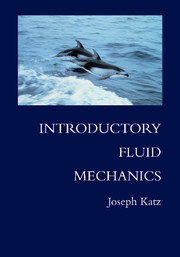Book contents
- Frontmatter
- Contents
- Preface
- A Word to the Instructor
- 1 Basic Concepts and Fluid Properties
- 2 The Fluid Dynamic Equation
- 3 Fluid Statics
- 4 Introduction to Fluid in Motion – One-Dimensional (Frictionless) Flow
- 5 Viscous Incompressible Flow: Exact Solutions
- 6 Dimensional Analysis and High-Reynolds-Number Flows
- 7 The (Laminar) Boundary Layer
- 8 High-Reynolds-Number Flow over Bodies (Incompressible)
- 9 Introduction to Computational Fluid Dynamics
- 10 Elements of Inviscid Compressible Flow
- 11 Fluid Machinery
- Appendix A Conversion Factors
- Appendix B Properties of Compressible Isentropic Flow
- Appendix C Properties of Normal Shock Flow
- Index
5 - Viscous Incompressible Flow: Exact Solutions
Published online by Cambridge University Press: 05 June 2012
- Frontmatter
- Contents
- Preface
- A Word to the Instructor
- 1 Basic Concepts and Fluid Properties
- 2 The Fluid Dynamic Equation
- 3 Fluid Statics
- 4 Introduction to Fluid in Motion – One-Dimensional (Frictionless) Flow
- 5 Viscous Incompressible Flow: Exact Solutions
- 6 Dimensional Analysis and High-Reynolds-Number Flows
- 7 The (Laminar) Boundary Layer
- 8 High-Reynolds-Number Flow over Bodies (Incompressible)
- 9 Introduction to Computational Fluid Dynamics
- 10 Elements of Inviscid Compressible Flow
- 11 Fluid Machinery
- Appendix A Conversion Factors
- Appendix B Properties of Compressible Isentropic Flow
- Appendix C Properties of Normal Shock Flow
- Index
Summary
Introduction
In Chapter 3 the effects of pressure in a fluid were isolated (because the fluid was not moving), and in Chapter 4 the inertia terms were added. The inclusion of viscosity, its effects, and the resulting velocity distribution are discussed here. For example, the velocity distribution for the laminar flow inside a pipe is formulated and the average velocity is calculated. This provides the relation between the simple 1D average velocity model (of Chapter 4) and the more complex (and realistic) 2D or 3D flows.
The solutions presented early in this chapter are often called exact solutions. This means that, for a few limited cases, a set of logical assumptions leads to simplification of the fluid dynamic equations, which allows their solution (for laminar flow)! Also, the cases presented in this chapter (e.g., the flow in pipes) is often termed as internal flows. The discussion on external flows is delayed to the following three chapters.
The second part of this chapter demonstrates the approach that evolved during the past 200 years for solving fluid dynamic problems (because there is no closed-form analytic solution to the complete fluid dynamic equations). According to this approach, to develop a practical engineering solution, we must start with a simple but exact solution that determines the major parameters and the basic trends of the problem (e.g., the pressure drop in a circular pipe versus the Reynolds number).
- Type
- Chapter
- Information
- Introductory Fluid Mechanics , pp. 142 - 212Publisher: Cambridge University PressPrint publication year: 2010



